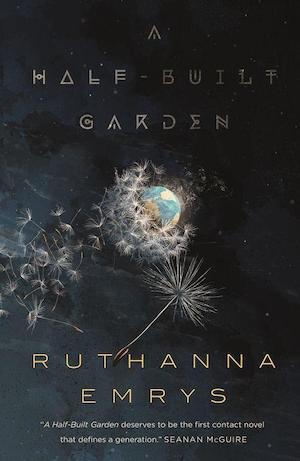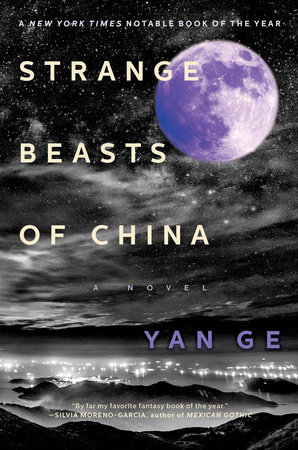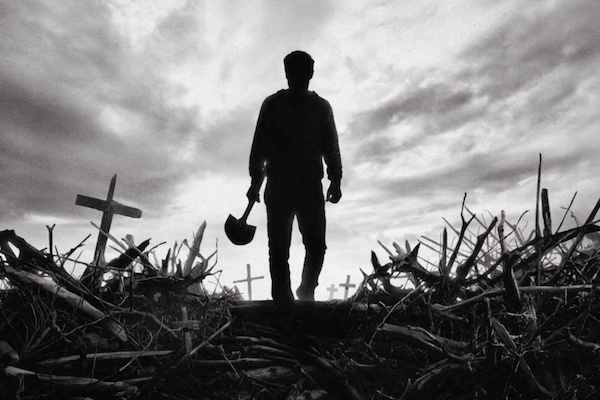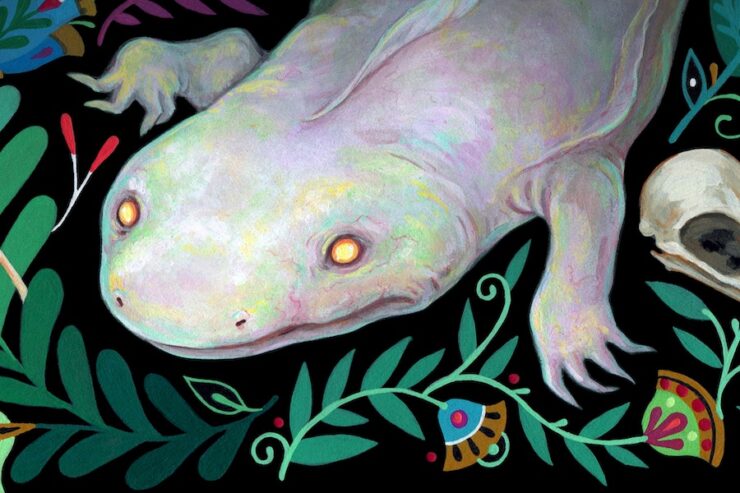Welcome back to Reading the Weird, in which we get girl cooties all over weird fiction, cosmic horror, and Lovecraftiana—from its historical roots through its most recent branches.
This week, we cover Yan Ge’s “Sorrowful Beasts,” first published in the Fall 2017 issue of Two Lines Journal. It appears for the first time in English, translated by Jeremy Tiang, as Chapter 1 of 2020’s Strange Beasts of China. Spoilers ahead!
“Legend has it that a sorrowful beast’s smile is so beautiful, no one who sees it could ever forget it.”
Yong’an City is home to both humans and to beasts. At night, animal cries fill the air. Unnamed narrator, a Yong’an City native, habituated early to the noise. Her mother told her “You can’t be sure that beasts aren’t people, or that people aren’t just another type of beast.” Nevertheless, people will always be scared of beasts. At university, narrator studied with a famous zoologist; though she left to become a novelist. He scolds her for choosing such a lowly profession, but they remain in contact. Her interest in beasts persists, and she earns extra income writing newspaper stories about them.
Sorrowful beasts are an ancient breed, possibly descended from a poet. They’re gentle, preferring cold dark places and bland foods, fearing trains, bitter gourd, and satellite TV. The males are tall, with large mouths and small hands. Their left calves sport scales, their right ears a fin; their circumnavel skin is dark green. The females are beautiful, with reddish skin, narrow eyes, and larger-than-normal ears. Around the full moon, they lose human speech and squawk like birds. Sorrowful beasts never smile or laugh, hence their name. If they do smile, they can’t stop until they die.
Otherwise, sorrowful beasts are just like regular people. Many males, being dextrous, work in the weaving industry. So many females marry wealthy humans that the government regulates this “commerce.” Males cannot mate with human females.
The artist Lefty tells narrator about “her” sorrowful beast, Cloud. He followed Lefty home one night, and she tamed him. In return for shelter and vanilla ice cream, he cooked and cleaned for her and purred like a cat under her caresses. They slept together, but couldn’t make love. Lefty painted many portraits of Cloud and had a successful exhibition of them.
On a full moon night, Cloud and Lefty heard a cry like a phoenix’s. It was Cloud’s sister Rain, the wife of a wealthy human. Flushed and ill, she clung to Cloud and emits shrill bird-cries. Her husband had no idea what to do—why should he, he was no beast! But when a doctor determined Rain pregnant, her elated husband sent the Mercedes-Benz to pick her up. Next morning, Cloud was dead, though he never smiled. Lefty hopes narrator can figure out what killed him.
Narrator’s former professor enigmatically directs her to a recent newspaper photo of Lefty out with the son of a construction magnate. He warns her not to poke into Cloud’s death, and anyway, Cloud might not have died. His soul might be immortal. Narrator asks if the professor means the City of the Dead, a legendary realm beneath Yong’an City where humans and beasts live forever. Before he responds, their call cuts out.
Narrator visits Rain, who serenely claims to have no brother. Retiring to her favorite bar, narrator meets Charley, a notorious gossip. He can offer no leads. A visit to the government archives unearths regulations concerning human/beast intermarriage. The beasts must undergo hypnosis or surgery to eliminate their memories, and take hormones to suppress their beastly natures for most of the month. New hormone treatments may eventually stop even their full moon lapses, keeping the beasts always human. They’ll still die if they smile, however.
Lefty continues seeing He Qi, the magnate’s son, but often talks to narrator about Cloud. Narrator learns that He Qi bought all Lefty’s Cloud portraits. She asks him why; he answers that he’s in love without clarifying whether his object is Lefty or Cloud. Like the professor, he thinks Cloud has an immortal soul.
Narrator visits the sorrowful beast quarter. She buys ice cream for a boy beast. He’s curious about her odd expression. It’s a smile, she explains. The boy says that beasts call a “smile” the pain which leads to death. One day, because she’s nice, he’ll marry narrator. His father said he could marry a human, see, only then the human woman would laugh, which is what her people would call dying.
Charley finally admits he introduced He Qi to Lefty—He Qi said he loved her subject, Cloud. Lefty wonders if beasts and humans can love. Actual beasts, not the hormone-drugged females. She confesses she loves He Qi. Narrator remembers how her professor once showed her his collection of specimen beasts. The male sorrowful beast was belly-slit, and under his green navel patch was a gaping void bordered by tight-packed teeth, his “true” mouth.
Narrator’s mother used to say, “The beasts all want to eat people, just as people want to eat them.”
Buy the Book


A Half-Built Garden
Scientists give Rain the experimental hormones, but she proves allergic. She runs naked through the streets, her fetus visible through her near-transparent belly. She smiles the whole time, dazzling as a goddess. Then, with a shattering cry, she dies.
The sorrowful beasts protest the new hormones. The government gives Rain a lavish funeral. Narrator attends, as do He Qi and Lefty. Over He Qi’s tearful entreaties, Lefty insists on viewing Rain’s body; doing so, she smiles radiantly, peals proud birdsong, and dies.
Lefty’s autopsy reveals the teeth beneath her green belly and the half-digested remains of the real Lefty. It seems that on full-moon nights, male sorrowful beasts are able to mate with human females; at climax, the beast opens his belly-mouth and swallows the human whole. He then takes on her likeness and so becomes a new female beast, perpetuating the species.
Narrator’s final note is that sorrowful beasts are faithful, seeking only one mate. Where her account went wrong was in her assumption that the love story was between Lefty and He Qi, when really “it was a tragedy of him and him,” He Qi and Cloud.
What’s Cyclopean: Jeremy Tiang’s straightforward, matter-of-fact English makes intense events and emotions all the more startling.
The Degenerate Dutch: The government deals with worries about female sorrowful beasts marrying rich male humans by regulating—and taxing (or possibly taking bribes to approve)—such marriages.
Weirdbuilding: What is a human, and what is a beast. And are any, or all, of them monsters?
Libronomicon: Narrator is a novelist; everyone seems to disapprove.
Madness Takes Its Toll: Female sorrowful beasts must become amnesic when they marry humans. What further psychological effects this might have is left as an exercise for the reader.
Ruthanna’s Commentary
“The chapters are more like interlinked short stories,” Anne told me, and indeed this first chapter stands alone even as it feels like one piece of a larger, and even stranger, puzzle. It reminds me of Italo Calvino’s Invisible Cities, where each chapter offers a seemingly isolated tourist summary until you start to see choruses of similarity amid the variation. The sorrowful beasts feel like something that’s going to rhyme later on.
Also familiar is the fuzzy line between metaphor and fantasy. There is, in Strange Beasts of China, an actual city where humans war and mingle with a multitude of beasts, where beasts take on jobs that suit their talents and get caught up in the human tendency to exoticize, and to turn the exotic into desired luxury, and to turn desire into ownership. But through another lens, the city is full of immigrants and less recent immigrants, who struggle to find niches to survive in or to keep others trapped in those niches, who fear assimilation and loss, and who face the possibility that new people and ideas might change their own familiar natures into… something else. And there’s me, an American reader trying to understand this whole thing through a cockeyed lens, knowing more about how these issues play out in my own country than in Yan Ge’s.
The fuzzy line between metaphor and fantastic reality is also the fuzzy line between human and beast. Narrator’s mother says that maybe humans are just another kind of beast. Narrator’s own nature is ambiguous: she’s subject to rules in her interactions with beasts, though perhaps the source of those rules is the newspaper that pays her. Everyone she interacts with seems to know things she doesn’t—and to think she’d be better off not knowing. She asks a beast to call her Big Sister. Is she a beast who’s forgotten her nature? A human who’s taken on, or been taken by, beastly characteristics? A beast being cagey with readers? If beasts are all forced to give up their beastly nature, then novelists like Narrator will be given injections to force them into dull and practical work. To make something of themselves by taming themselves. Perhaps all artists are beasts. I do howl when someone turns on the TV.
The eagerness of humans to both exploit and erase the beasts is also familiar, and horrifying. No coincidence, perhaps, that it’s the females who are hypnotized, drugged, and altered to erase their memories, to suppress their natures. The rich husbands know what they have, of course. And, presumably, fear what that thing might do if allowed to be itself. Isn’t it nice that this sort of thing is fictional? You can read about it in Marge Piercy’s Woman on the Edge of Time, too, or any number of (purely fictional, of course) articles about the history of lobotomy.
Interesting that Narrator doesn’t remember researching those hormonal treatments previously. Nothing suspicious about that at all.
Human women, it turns out, also get a lousy end of this deal: eaten and replaced by male sorrowful beasts as part of a reproductive cycle that’s more complicated and anthropophagous than it first appears. It’s not clear whether the now-female beast then gets together with a still-male beast to produce new beastlets, or whether some of the perfectly-human offspring of male-human/female-beast unions actually turn into male sorrowful beasts later on.
It’s the ciiiircle of liiiife… as Narrator’s mother also says. I’m very curious who—and what—she was.
Anne’s Commentary
Like the cryptids it describes, Yan Ge’s Strange Beasts of China has a complicated history. The Chinese magazine Youth Literature serialized some chapters in 2005 when the author was twenty or twenty-one. The novel saw its original publication as Yi Shou Zhi in 2006. “Sorrowful Beasts” migrated to Two Lines Journal 27 in 2017, while “Flourishing Beasts” made its way to That We May Live: Chinese Speculative Fiction in 2020. Now, thanks to Jeremy Tiang’s translation, English readers can enjoy the entire bestiary.
And a bestiary it is, in part. Many are the other-than-human inhabitants of Yong’an City. Besides the Sorrowful Beasts, there are Joyous Beasts and Sacrificial Beasts and Impasse Beasts, Flourishing Beasts and Thousand League Beasts, Heartsick Beasts, Prime Beasts, Returning Beasts! Add in the humans, who for all their pretensions may be just another species of beast, and you have quite the metropolitan menagerie. As in medieval compendiums of real and/or imaginary beings, each of Yan’s chapters includes a natural history of its titular beast; unlike the typical medieval naturalist, she avoids moral interpretation, leaving beastly behavior ambiguous. All Yong’an City beasts are basically humaniform at maturity, with varying degrees of sexual dimorphism and nonhuman features. Sorrowful Beasts establish the pattern. The males are the more obviously beastly, with their calf scales and ear fins and green bellies. The females could pass for beautiful human women, if it wasn’t for their unfortunate habit of squawking like birds during every full moon. The females can even have sex and offspring with humans, while the males (supposedly) cannot.
Yong’an City zoologists don’t know everything about beasts, nor do they reveal all they do know. Rumors and legends abound, fueling narrator’s fascination for beasts as she plunges into one mystery after another. Tortuously knotty mysteries they are, too. I found that every chapter in Strange Beasts required page-hopping for missed clues. Having reread “Sorrowful Beasts” several times, I think I’ve figured it out enough to admire Yan’s subtlety rather than to curse her darkness.
The narrator’s newspaper editor expects her cryptozoological tales to feature public-pleasing romance. With short deadlines, the narrator must dig fast for love angles; with limited words-per-piece, she must establish her lovers without long build-ups. However, only the complex truth of interpersonal/interspecies connection can satisfy her intellectually and emotionally. Her core (if not always self-acknowledged) belief is that connections are possible—in every description of every beast, narrator lists its deviations from the human norm, then concludes with some variation of “Otherwise, they’re just like regular people.”
In “Sorrowful Beasts,” the mystery is who loves whom. More pertinently, who CAN love whom? Human males desire Sorrowful females as status symbols and breeders, but can they truly love mates chemically and surgically stripped of their essential memories and wildness? Can the bought and tamed and denatured Sorrowful wives love human husbands? Lefty seems to love Cloud though their intimacy is limited, but does she love him as more than a pet and her painterly Muse? Cloud purrs around Lefty, but how deep does this feral cat’s contentment go? Who is He Qi in love with, the painter Lefty or the subject of her paintings? He Qi won’t say, but Charley claims He Qi loves Cloud. After Cloud’s “death,” Lefty becomes He Qi’s lover, but she still asks the narrator if she thinks love’s possible between beasts and humans. Immediately afterwards, she says she loves He Qi. So, isn’t that human to human love?
Out of this tangle, narrator concludes that the central love story is He Qi’s and Lefty’s. The denouement comes at Rain’s funeral, when Lefty reveals she isn’t Lefty at all but Cloud, who in mourning his sister smiles himself to death. So Charley was right: He Qi loved Cloud. Cloud, speaking in his Lefty-disguise, tells the truth: Cloud loved He Qi, and so theirs was the ultimate tragedy. How Gordian a knot do all these plot twists tie? Were He Qi and Cloud in love before Cloud followed Lefty home—which would suggest that Cloud was all along targeting Lefty as his ticket to sex switching? Did Cloud need to pass as a human female in order to be a socially acceptable lover for He Qi? If He Qi is gay, can he be happy with the feminized Cloud? Maybe He Qi is bisexual? Can human love beast and beast love human? Looks like it, since Lefty-Cloud is still a beast, and Lefty-Cloud and He Qi are our tragic couple?
If Cloud swallowed Lefty and then assumed Lefty’s appearance, what body remained to represent a dead Cloud? Maybe Lefty-Cloud doesn’t need to produce a Cloud body in order to satisfy the authorities, Cloud being merely a beast? Maybe the new Cloud leaves behind an old Cloud husk?
So many questions about biases and other-fears and other-exploitation, love and sex, identity and gender-shifting. Gender-shifting through magical-psychical bodysnatching! Whoa, Yan’s “Sorrowful Beasts” may outdo even Lovecraft’s “Thing on the Doorstep” for this kind of mind-scrambling fun!
If you’d like more of the same, and even tricksier, I recommend reading the rest of the novel.
Next week, we continue Joseph Sheridan Le Fanu’s Carmilla, Chapters 5-6, in which a sweet, innocent young lady settles in with her hosts.
Ruthanna Emrys’s A Half-Built Garden comes out in July 2022. She is also the author of the Innsmouth Legacy series, including Winter Tide and Deep Roots. Her short story collection, Imperfect Commentaries, is available from Lethe Press. You can find some of her fiction, weird and otherwise, on Tor.com, most recently “The Word of Flesh and Soul.” Ruthanna is online on Twitter and Patreon, and offline in a mysterious manor house with her large, chaotic, multi-species household outside Washington DC.
Anne M. Pillsworth’s short story “The Madonna of the Abattoir” appears on Tor.com. Her young adult Mythos novel, Summoned, is available from Tor Teen along with sequel Fathomless. She lives in Edgewood, a Victorian trolley car suburb of Providence, Rhode Island, uncomfortably near Joseph Curwen’s underground laboratory.














Fantastic! It’s such a fairy tale in the deep sense that it speaks of real pain and injustice through a fantastic prism. I listened to this one on audiobook and plan to finish the entire volume.
I felt the same way, like there was a millennia worth of metaphor and cultural understanding going on that I was just scratching the surface. I was about to call that it’s own sort of Weird, but realized that this was another example of exoticising- a trap I fell right into, just like Lefty. Or, do we think she knew just what she was doing?
As a queer woman who lived in Shanghai for years, this review has kind of blown my mind. I’ve ordered the book and I am so excited to read it.
This is 100% like The Thing on the Doorstep, although I dare say Yan Ge knows what she’s doing whereas Lovecraft maybe didn’t realize how much he was tipping his hand. This is such a deeply Chinese love story (from the sound of it) and such a Chinese way of looking at the arts.
Thank you so, so much.
Iris @@@@@ 2: I’m so glad! One of the pleasures of this column is introducing people to the good stuff (and getting introduced to it ourselves).